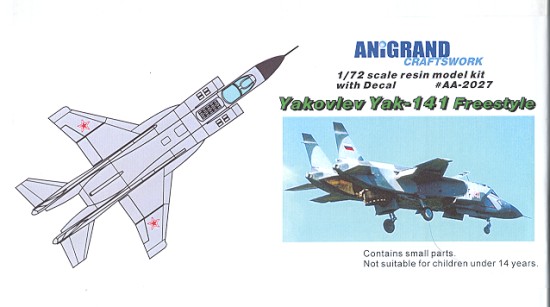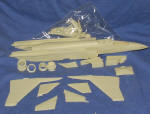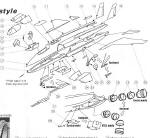
| KIT: | Anigrand 1/72 Yak-141 'Freestyle' |
| KIT # | AA-2027 |
| PRICE: | $58.00 MSRP |
| DECALS: | one option |
| REVIEWER: | Scott Van Aken |
| NOTES: | Short run resin kit with vac canopy |

| HISTORY |
The Yak-141 is the world's first supersonic VTOL fighter. It operates with lift engines in the forward fuselage and a vectoring nozzle on the main engine, placed well forward, between twin tail booms. The Yak-141 seems to be more a technology demonstrator than an actual fighter aircraft, and the need to use afterburner for take-off is a distinct problem. Development is continuing, after being halted temporarily.
Design of the Yak-41 began in 1975; the first prototype flew on 9 March 1987, followed by a second in April 1989. Tests were conducted on the aircraft carrier "Admiral Gorshkov". In April 1991, one of the prototypes set several records for VTOL aircraft; it was displayed at the Paris Air Show shortly afterwards. One prototype was lost in a crash (attributed to pilot error) on the carrier in November 1991, after which development was suspended (due to lack of funds rather than any problems with the aircraft); the surviving aircraft was mothballed.
Yakovlev have recently announced their intention to restart development of the Yak-41, apparently as a result of renewed interest from the Russian Ministry of Defense (a similar revival of the twin-turboprop Yak-44 AEW aircraft is also being considered).
A more advanced version, has also been designed, with the emphasis now on Air Force rather than Navy service. This version has an extensively modified airframe, with a strong emphasis on stealth (there is a distinct resemblance to the F-22), a much more powerful engine, and more fuel and payload.
The "Freestyle" has been referred to as both Yak-41 and Yak-141; it appears that one designation refers to the standard fighter (Yak-41) and one to the single prototype modified for record attempts (Yak-141).
Thanks to www.fighter-planes.com for the historical background.
| THE KIT |
 Once again, Anigrand goes where others fear to tread. This time they have concentrated on a most interesting prototype aircraft, the Yak-141 'Freehand'. Though it doesn't look like a large aircraft, it actually is longer than an F-18 Hornet.
Once again, Anigrand goes where others fear to tread. This time they have concentrated on a most interesting prototype aircraft, the Yak-141 'Freehand'. Though it doesn't look like a large aircraft, it actually is longer than an F-18 Hornet.
Packaged as are all their kits, in a multi-sectioned plastic bag, the parts arrived intact and undamaged in their sturdy box. It also seems as if Anigrand is using a thicker plastic for their bags. Good show. Though it didn't stop the pointy nose from breaking through, none of the other compartments were breached, a problem with some of their earlier kits.
 Now I've weenied out and not opened the bag with the small bits for fear of losing some of them. Instead, the image shows all the major bits and the drawing shows the others. As you can see, there is the option to build the kit for vertical or horizontal flight. There are covers for the upper lift engines and the exhaust for the lower lift engines are provided as separate pieces. You are also supplied with different main engine nozzles for horizontal or vertical flight. The lower fuselage plate can be cut to provide the vertical take off mode.
Now I've weenied out and not opened the bag with the small bits for fear of losing some of them. Instead, the image shows all the major bits and the drawing shows the others. As you can see, there is the option to build the kit for vertical or horizontal flight. There are covers for the upper lift engines and the exhaust for the lower lift engines are provided as separate pieces. You are also supplied with different main engine nozzles for horizontal or vertical flight. The lower fuselage plate can be cut to provide the vertical take off mode.
The parts themselves are typical of previous Anigrand kits. There are a few small air bubble holes that will have to be dealt with and some of the thinner pieces, such as the inside intake sections, have warpe d and will need straightening. Not a problem for those who have dealt with resin kits before. No indication of any required nose weight is given, but judging from the bulk of resin that is aft of the main wheels, I'd think that some will be needed. This will put additional stress on the nose gear and so I'd be hunting around in the spares box for a plastic or metal replacement, as the additional weight may well cause the resin to deform in a relatively short time.
d and will need straightening. Not a problem for those who have dealt with resin kits before. No indication of any required nose weight is given, but judging from the bulk of resin that is aft of the main wheels, I'd think that some will be needed. This will put additional stress on the nose gear and so I'd be hunting around in the spares box for a plastic or metal replacement, as the additional weight may well cause the resin to deform in a relatively short time.
The Anigrand instructions are also quite typical of previous kits with a brief historical background that includes photos of the exhaust in both lift and cruise mode. The assembly section is basically an exploded drawing as you can see above. This is fine and works well in most instances. The other side of the sheet is a color and markings three view. This shows one of the prototypes in an overall grey that is listed as light ghost grey. Makes for easier painting, though the adventurous will want to give the multi-hued camouflage scheme shown on the box top a try. There are markings for two aircraft. You can do #77 or #144. You also have the option of using the Russian flag on the fin instead of the usual Red Star. Anigrand decals are a bit thick and previous ones did not respond well to compound curves, but there are none on this kit so they should work just fine. They are also printed on a white background which is why you can't see some of them!
| CONCLUSIONS |
As with all short run kits, this one will require cleanup to get ready and some skill to build. However, the end result will be a most unusual aircraft that few modelers will have on their shelves. If your interest is with something outside the mainstream, then this is a kit you should buy.
Many thanks to DMC Models for the review kit.
UPDATE: Nostalgic Plastic is now the US Importer for Anigrand. Please contact them for more information.
If you would like your product reviewed fairly and fairly quickly by asite that has nearly 300,000 visitors a month, please contactme or see other details in the